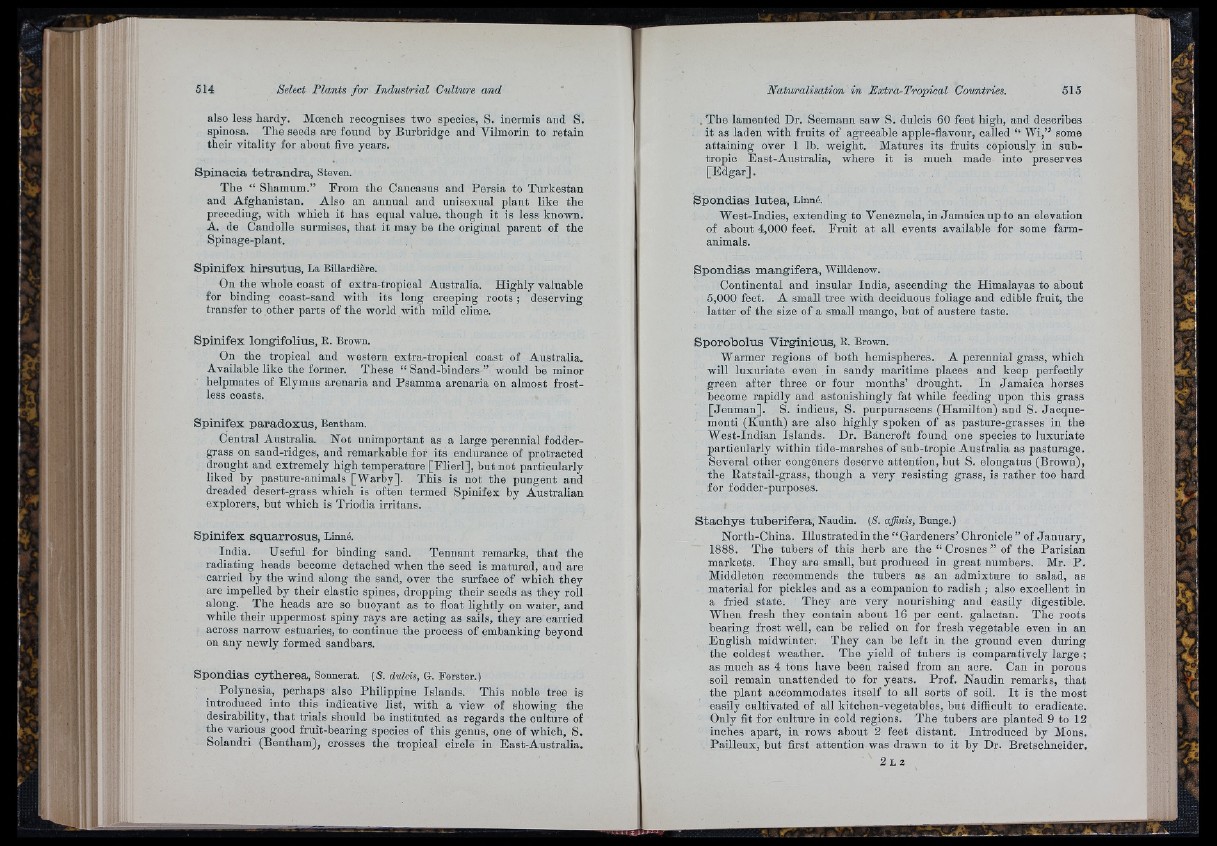
also less hardy. Moencli recognises two species, S. inermis and S.
spinosa. The seeds are found by Burbridge and Vilmorin to retain
their vitality for about five years.
Spinacia tetrandra, Steven.
The “ Shamum.” From the Caucasus and Persia to Turkestan
and Afghanistan. Also an annual and unisexual plant like the
preceding, with which it has equal value, though it is less known.
A. de Candolle surmises, that it may be the original parent of the
Spinage-plant.
Spinifex hirsutus, La Biliardière.
On the whole coast of extra-tropical Australia,
for binding coast-sand with its long creeping
Highly valuable
roots ; deserving
transfer to other parts of the world with mild clime.
Spinifex longifolius, R. Brown.
On the tropical and western extra-tropical coast of Australia.
Available like the former. These “ Sand-binders ” would be minor
helpmates of Elymus arenaria and Psamma arenaria on almost frostless
coasts.
Spinifex paradoxus, Bentham.
Central Australia. Not unimportant as a large perennial fodder-
grass on sand-ridges, and remarkable for its endurance of protracted
drought and extremely high temperature [Flie rl], but not particularly
liked by pasture-animals [Warby], This is not the pungent arid
dreaded desert-grass which is often termed Spinifex by Australian
explorers, but which is Triodia irritans.
Spinifex squarrosus, Linné.
India. Useful for binding sand. Tennant remarks, th a t the
radiating heads become detached when the seed is matured, and are
carried by the wind along the sand, over the surface of which they
are impelled by their elastic spines, dropping their seeds as they roll
along. The heads are so buoyant as to float lightly on water, and
while their uppermost spiny rays are acting as sails, they are carried
across narrow estuaries, to continue the process of embanking beyond
on any newly formed sandbars.
Spondias cytherea, Sonnerat. (S. dulcis, G. Forster.)
Polynesia, perhaps also Philippine Islands. This noble tree is
introduced into this indicative list, with a view of showing the
desirability, th a t trials should be instituted as regards the culture of
the various good fruit-bearing species of this genus, one of which, S.
Solandri (Bentham), crosses the tropical circle in East-Australia.
.T h e lamented Dr. Seemann saw S. dulcis 60 feet high, and describes
it as laden with fruits of agreeable apple-flavonr, called “ Wi,” some
attaining over 1 lb. weight. Matures its fruits copiously in subtropic
East-Australia, where it is much made into preserves
[E d g a r].
Spondias lutea, Linné.
West-Indies, extending to Venezuela, in Jamaica up to an elevation
of abont 4,000 feet. F ru it a t all events available for some farm-
animals.
Spondias mangifera, Willdenow.
Continental and insular India, ascending the Himalayas to ahout
6,000 feet. A small tree with deciduous foliage aud edible fruit, the
latter of the size of a small mango, but of austere taste.
Sporotaolus Virginicus, R. Brown.
Warmer regions of both hemispheres. A perennial grass, which
will luxuriate even in sandy maritime places aud keep perfectly
green after three or four months’ drought. In Jamaica horses
become rapidly and astonishingly fat while feeding upon this grass
[Jenman]. S. indicus, S. purpurascens (Hamilton) and S. Jacque-
monti (Kunth) are also highly spoken of as pasture-grasses in the
West-Indian Islands. Dr. Bancroft found one species to luxuriate
particularly within tide-marshes of sub-tropic Australia as pasturage.
Several other congeners deserve attention, but S. elongatus (Brown),
the Ratstail-grass, though a very resisting grass, is rather too hard
for fodder-purposes.
Stachys tuberifera, Naudin. (S. affinis, Bunge.)
North-China. Illustrated in the “ Gardeners’ Chronicle” of January,
1888. The tubers of this herb are the “ Crosues ” of the Parisian
markets. They are small, hut produced in great numbers. Mr. P .
Middleton recommends the tubers as an admixture to salad, as
material for pickles and as a companion to radish ; also excellent in
a fried state. They are very nourishing and easily digestible.
When fresh they contain about 16 per cent, galactan. The roots
bearing frost well, can be relied on for fresh vegetable even in an
English midwinter. They can be left in the ground even during
the coldest weather. The yield of tubers is comparatively large ;
as much as 4 tons have been raised from an acre. Can in porous
soil remain unattended to for years. Prof. Naudin remarks, that
the plant accommodates itself to all sorts of soil. I t is the most
easily cultivated of all kitchen-vegetables, but difficult to eradicate.
Only fit for culture in cold regions. The tubers are planted 9 to 12
inches apart, iu rows about 2 feet distant. Introduced by Mons.
Pailleux, but first attention was drawn to it by Dr. Bretschneider.